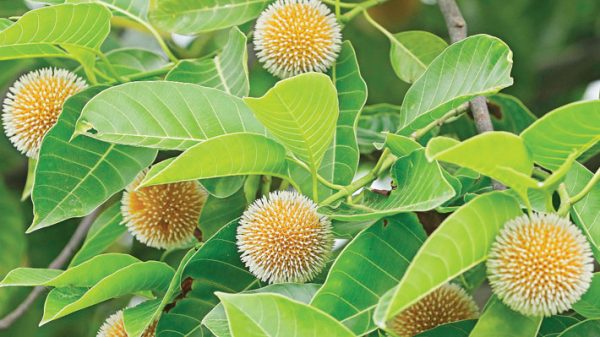Kadam: The signature flower of monsoon

Shawdesh desk:
Whenever anyone thinks of the monsoon, which begins today with the first day of Ashar, the picture that comes to his/her mind is a bunch of glossy flowers peeking out in clusters amidst the green leaves apart from incessant rain soaking everything.
It is so easy to guess the name of the flower that anyone can name it even if no hint is given. And it is none other than Kadam.
Earning a permanent place in mythology, literature and culture, the round-shaped flower of a golf ball size has become synonymous to the rainy season, comprised of the Bangla months of Ashar and Sharabon, with its unique look and fragrance.
Be it the Baishnab poets of the Middle Age, Rabindranath Tagore, Kazi Nazrul Islam or any poet or writer of their subsequent generation, Kadam as a flower has never failed to fascinate creative minds.
From ‘Shri Krishnakirtan’ by Baru Chandidas, numerous poems and songs by Rabindranath Tagore and Kazi Nazrul Islam, ‘Polli Borsha’ by Jasim Uddin, ‘Kadam Phuler Itibritto’ by Al Mahmud, ‘Amon Borshar Dine’ by Shamsur Rahman to novels, songs and drama written by Humayun Ahmed, love for Kadam is evident in all genres of literature.
Eminent literary figures took Kadam as the subject of their writings observing the intimate connection between Barsha (monsoon) and the amazing flower in ordinary people’s lives.
Kadam blooms profusely during every rainy season. The colour of the mesmerising flower is somewhere between yellow and orange and the surface of this densely pollen-covered ball juts numerous short white filaments all around.
The soft texture of the white filaments soothes the eyes of the nature lovers and its sweet fragrance captivates nostrils.
The beauty of the flower degrades when it starts to ripen. It emanates a mild but strange odour at that time. This is the smell that most people are acquainted with. However, the fragrance of the freshly-bloomed flower is sweeter.
The fragrance attracts many insects, including bees, which converge on the flower and help with pollination. Later, as the Kadam ripens, the birds like bulbul and black-hooded oriole come to feast on it.
There are controversies over the scientific name of Kadam. Scottish botanist William Roxburgh named it Nauclea cadamba while the Kadam tree is also called Anthocephalus cephalus.
When it comes to Kadam’s Bangla or Sanskrit name, it is known or called as Neep, Surovi, Brittopushpo, Kornopurok, Bhringobollov, Monjukeshini, Pulki, Shoshorpo, Prabissho and Shindhupushpo.
The origin of the tree also appears controversial as some claim it came from Madagascar but others say it was first found in warm areas of India and China.
Kadam trees are relatively easy to grow in Bangladesh’s climate and soil. They can reach heights of 150 feet with a strong, erect trunk, a broad, dense crown. Left untrimmed, its radial branches grow long and thick.
The wood is used for pulp, paper mills, plywood, boxes and crates as it is not strong enough for making furniture or using in other works.
But different parts of the Kadam tree have medicinal uses. According to researchers, it is crucially significant as it has the largest number of phytochemicals and secondary metabolites having pharmacological and biological properties.
Kadam tree can be used as an alternative to various synthetic chemical compounds in the prevention as well as the treatment of several incurable diseases.
In this age of urbanisation, when deforestation has become a common phenomenon, there are still some Kadam trees besides Dhaka’s Ramna Park, Bangladesh Shilpakala Academy and Bakshi Bazar, and other areas of a few major cities. During the rainy season, clusters of Kadam flowers in these trees look like a golden tiara on the green head.























Leave a Reply